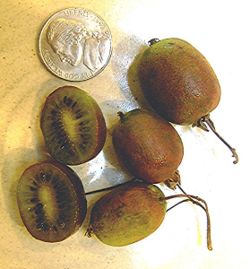Hardy Kiwi
| Hardy Kiwi Fossil range: {{{fossil_range}}}
| ||||||||||||||||||||||||||||||||||||||||||||||||||||||||||||||||||
|---|---|---|---|---|---|---|---|---|---|---|---|---|---|---|---|---|---|---|---|---|---|---|---|---|---|---|---|---|---|---|---|---|---|---|---|---|---|---|---|---|---|---|---|---|---|---|---|---|---|---|---|---|---|---|---|---|---|---|---|---|---|---|---|---|---|---|
 Hardy Kiwi | ||||||||||||||||||||||||||||||||||||||||||||||||||||||||||||||||||
| Plant Info | ||||||||||||||||||||||||||||||||||||||||||||||||||||||||||||||||||
| ||||||||||||||||||||||||||||||||||||||||||||||||||||||||||||||||||
| Scientific classification | ||||||||||||||||||||||||||||||||||||||||||||||||||||||||||||||||||
| ||||||||||||||||||||||||||||||||||||||||||||||||||||||||||||||||||
| [[{{{diversity_link}}}|Diversity]] | ||||||||||||||||||||||||||||||||||||||||||||||||||||||||||||||||||
| {{{diversity}}} | ||||||||||||||||||||||||||||||||||||||||||||||||||||||||||||||||||
| Binomial name | ||||||||||||||||||||||||||||||||||||||||||||||||||||||||||||||||||
| Actinidia arguta | ||||||||||||||||||||||||||||||||||||||||||||||||||||||||||||||||||
| Trinomial name | ||||||||||||||||||||||||||||||||||||||||||||||||||||||||||||||||||
| {{{trinomial}}} | ||||||||||||||||||||||||||||||||||||||||||||||||||||||||||||||||||
| Type Species | ||||||||||||||||||||||||||||||||||||||||||||||||||||||||||||||||||
| {{{type_species}}} | ||||||||||||||||||||||||||||||||||||||||||||||||||||||||||||||||||
| {{{subdivision_ranks}}} | ||||||||||||||||||||||||||||||||||||||||||||||||||||||||||||||||||
| [[Image:{{{range_map}}}|{{{range_map_width}}}|]] | ||||||||||||||||||||||||||||||||||||||||||||||||||||||||||||||||||
| Synonyms | ||||||||||||||||||||||||||||||||||||||||||||||||||||||||||||||||||
| {{{synonyms}}} |
A small, green to purple skinned, fruit similar to kiwifruit, hardy kiwifruit is an edible, berry-sized fruit of a Cultivar Group of the woody vine Actinidia arguta. Often sweeter than the kiwifruit, hardy kiwifruit can be eaten whole and need not be peeled. Thin-walled, its exterior is smooth and leathery, providing a deceiving contrast to the fuzzy, brown exterior of its larger sibling fruits.
Common names include Kiwi Berry, Baby Kiwi, Dessert Kiwi or Cocktail Kiwi.
The fast-growing, climbing vine is very hardy (hence the name), and is capable of surviving slow temperature drops to -32°C (-25°F). The vines need a frost-free growing season of about 150 days, but are not damaged by late freezes. The vines can also be grown in low-chill areas.
The vines of the hardy kiwifruit possess a catnip like smell which can attract cats.Template:Verify source
Origin and Distribution
The hardy kiwifruit is native to Korea, Northern China, and Russian Siberia. Attempts to commercialize the fruit have been unsuccessful due to its short shelf-life and sporadic tendencies to ripen. Attempts are being made however to bring the fruit to greater bear, and commercial production initiatives are underway on a small scale in South America, New Zealand, Europe, and Oregon & Washington, USA, as well with some organic growers in northern New England.
External links
- NZKiwiberry (Information page at Delica exporting company)